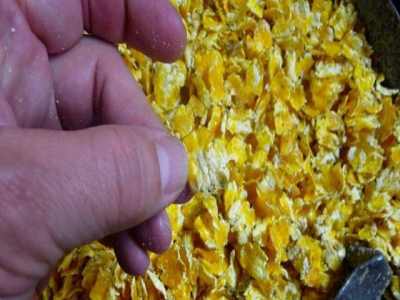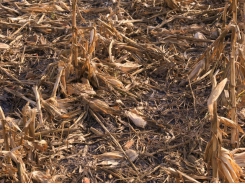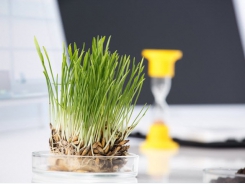Five tips for making high-quality flaked corn for cattle

Maximizing the surface area of grain to rumen microbes is a critical first step in optimizing performance in cattle.
Enter the words “flaked corn” into your internet search engine and the first few search results are related to the home brewing industry. The fermentation process which makes alcohol relies on maximum surface area to expose the starch inside the corn kernel to breakdown. This is the same process occurring in the rumen. To optimize performance in cattle, maximizing the surface area of grain to rumen microbes is a critical first step. Before grain is fed to cattle the grain is commonly steam flaked.
What is steam flaking and what happens when we steam flake grain? Steam flaking is the process of added increased moisture and heat over time to soften the grain before passing thru the rolls.1 Steam flaking increases the surface area of the grain, improves starch digestibility and ultimately enhances ruminant performance. This enhanced performance results in better lactation performance1 and improved growth performance in feedlot cattle.2
In a 12-trial summary, Dr. Richard Zinn observed that substitution of steam flaked corn for dry rolled corn in growing-finishing diets for feedlot cattle increased average daily gain by 6.3%.3 Starch is complexed in a matrix of protein, and steam-flaking corn not only improves the starch availability but releases protein from the matrix.
Modern steam chambers or steam chests have a capacity to process 20, 30 or even 40 tons of flakes per hour. To get the highest quality flakes, retention times often approach 60 minutes. This means the larger steam flaking systems hold 20-40 tons of grain, require massive amounts of high-quality steam and require massive amounts of energy to remain in production. And maintenance? Misaligned rolls wear rapidly so momentary lapses in routine maintenance can cause week-long operational shutdowns.
As you can imagine, steam flaking grain is as much art as it is science. Operators who try the “set-it-and-forget-it approach” to producing good flakes learn very quickly this will not work. During the day grain moisture will change, steam quality can vary by the minute and roll settings require constant monitoring. So, what can operations do to improve flaked grain quality?
The list is obviously exhaustive, and the purpose of this article is not to diagnose every problem. However, in this article, we offer five tips which Kemin Animal Nutrition & Health – North America has determined will help most flaking operations.
Five Tips for Making High-Quality Flaked Corn for Cattle
- Use a surfactant or wetting agent like MYCOFLAKE®. When applied to grain prior to introduction into the steam chamber, MYCOFLAKE permits moisture to uniformly and deeply penetrate each kernel. Surfactants work to reduce the surface tension of water, increasing moisture uptake by the grain. MYCOFLAKE helps increase the thermal conductivity of the grain and increase starch gelatinization.
- Increase steam chest temperature.4 Research has shown temperatures greater than 95°C (203°F) are required to induce starch gelatinization.
- Increase steaming time.4 Zinn demonstrated that steaming for more than 30 minutes did not enhance either starch digestibility or the net energy value of flaked corn.5 However, because steam time is often a function of maximum roller mill capacity at a given flake density and the size of the steam chest, many flakes are not exposed to 30 minutes of steam.
- Flake quality can vary greatly due to alterations in the gap between the flaking rolls. A fourth way to help make high-quality flakes is continually evaluate the roll gap. Uneven feeding of kernels along the rolls can widen the roll gap, permitting more whole kernels to pass between the rolls.4
- And finally, monitor roll tension. There are many methods for adjusting flaking roll tension before flaking. Work with your roll manufacturer to determine the best ram pressure or tension on the rolls so that you achieve the desired flake density.
Flaking grain is more of an art than a science. However, by using these five tips, you and your operation can make high-quality flaked corn for your operation.
Có thể bạn quan tâm
Phần mềm

Phối trộn thức ăn chăn nuôi

Pha dung dịch thủy canh

Định mức cho tôm ăn

Phối trộn phân bón NPK

Xác định tỷ lệ tôm sống

Chuyển đổi đơn vị phân bón

Xác định công suất sục khí

Chuyển đổi đơn vị tôm

Tính diện tích nhà kính

Tính thể tích ao hồ




 Brazil: Low feed prices could expand feedlot cattle…
Brazil: Low feed prices could expand feedlot cattle…  New in vitro tool estimates ruminal protein degradability
New in vitro tool estimates ruminal protein degradability